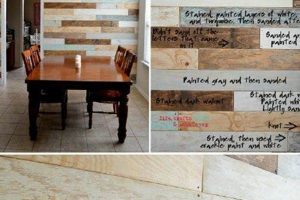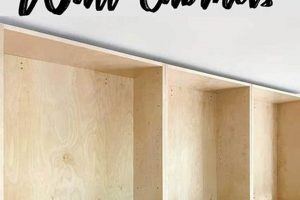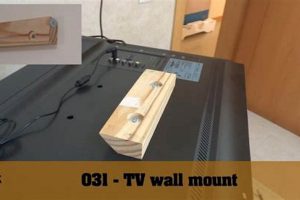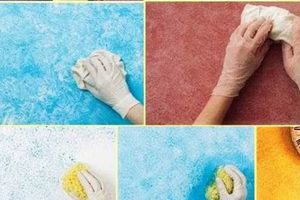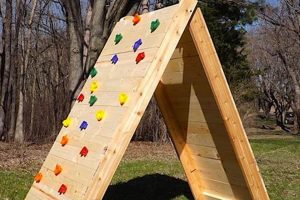Three-dimensional decorative elements applied to vertical surfaces represent a form of artistic expression increasingly accessible to individuals. These projects involve creating visually striking focal points within interior spaces, utilizing readily available materials and basic crafting techniques. For example, constructing geometric patterns from painted wood panels or assembling textured compositions from repurposed cardboard are implementations of this art form.
This type of wall adornment offers a cost-effective method for personalizing living or working environments, allowing for customization beyond conventional paintings or prints. Historically, decorative wall treatments were often the domain of professional artisans; however, the proliferation of online tutorials and accessible supplies has democratized the process, empowering individuals to create bespoke decor. The benefits extend beyond aesthetics, providing opportunities for creative exploration, skill development, and the satisfaction of producing unique artwork.
The subsequent sections will delve into specific techniques, material considerations, and design inspirations relevant to creating visually impactful and structurally sound three-dimensional wall decorations. Furthermore, guidance will be offered on project planning, execution, and installation, ensuring successful implementation for a range of skill levels.
Practical Guidance for Volumetric Wall Decor
Achieving visually appealing and structurally sound dimensional wall art requires careful planning and execution. The following guidelines offer key considerations for successful implementation.
Tip 1: Material Selection: Prioritize lightweight materials such as foam board, balsa wood, or corrugated cardboard to minimize wall strain. Consider material texture and potential for painting or other surface treatments.
Tip 2: Design Prototyping: Before commencing the final piece, create a small-scale model or digital rendering. This allows for visualization of the finished product and identification of potential design flaws.
Tip 3: Precise Measurements: Accurate measurements are crucial for ensuring proper alignment and symmetry. Employ a level and measuring tape to maintain consistent dimensions throughout the project.
Tip 4: Secure Adhesion: Select an appropriate adhesive based on the materials being used and the wall surface. Construction adhesive or heavy-duty mounting tape provides reliable support for three-dimensional elements.
Tip 5: Consistent Finishing: Apply paint or other finishes evenly to achieve a professional appearance. Multiple thin coats are preferable to a single thick coat, minimizing drips and ensuring uniform coverage.
Tip 6: Strategic Placement: Consider the surrounding environment when determining the artwork’s placement. Factors such as lighting, furniture arrangement, and existing wall decor should influence the final positioning.
Tip 7: Wall Preparation: Ensure the wall surface is clean, dry, and free of imperfections before installation. Light sanding may be necessary to promote better adhesion.
These key considerations facilitate the creation of visually striking and structurally sound dimensional wall decor, enhancing interior spaces with personalized artistic expression.
The concluding section will summarize the core principles discussed and offer suggestions for further exploration of techniques and design styles.
1. Material Selection
The selection of appropriate materials is paramount to the successful execution of dimensional wall art. Material properties directly influence the artwork’s aesthetic appeal, structural integrity, and ease of installation. Considerations extend beyond mere visual preference, encompassing weight, texture, durability, and compatibility with chosen adhesives and finishing techniques.
- Weight Considerations
Heavy materials, such as dense wood or metal, may require substantial wall reinforcement to prevent structural failure. Lightweight alternatives, including foam board, balsa wood, or corrugated cardboard, minimize stress on the wall and facilitate easier installation. The chosen material should be appropriate for the wall type (e.g., drywall, plaster, concrete) and its load-bearing capacity.
- Texture and Aesthetic Properties
The inherent texture of a material contributes significantly to the overall visual impact. Smooth surfaces, like acrylic or painted wood, offer a sleek, modern aesthetic, while textured materials, such as burlap or reclaimed wood, evoke a rustic or organic feel. Material choice should complement the existing interior design and reflect the desired artistic style.
- Workability and Fabrication
The ease with which a material can be cut, shaped, and assembled influences the complexity and feasibility of the design. Materials such as foam board are easily cut with a utility knife, while others, like metal, may require specialized tools and techniques. The selected material should align with the creator’s skill level and available resources.
- Adhesion Compatibility
Successful adhesion is crucial for securing three-dimensional elements to the wall. Different materials require specific adhesives to ensure a strong and durable bond. Porous materials, such as wood or cardboard, readily absorb adhesives, while non-porous materials, like plastic or metal, may require specialized bonding agents. Selecting compatible adhesives is essential for preventing detachment or damage over time.
In summary, the careful selection of materials is not merely a matter of aesthetic preference, but a critical factor determining the structural integrity, visual appeal, and longevity of dimensional wall art. A comprehensive understanding of material properties and their interactions is essential for achieving successful and enduring results. Further experimentation with unconventional materials and innovative techniques can yield unique and expressive artistic outcomes.
2. Spatial Awareness
Spatial awareness, in the context of creating three-dimensional wall art, constitutes the understanding of how objects occupy and interact within a given space, both physically and visually. The successful integration of dimensional elements necessitates a careful consideration of the wall’s dimensions, the surrounding environment, and the intended viewing perspective. A lack of spatial awareness can result in artwork that appears disproportionate, visually cluttered, or incongruous with the existing aesthetic. For example, a large, complex geometric sculpture, if placed on a small, confined wall, may overwhelm the space and detract from its intended impact. Conversely, a small, intricate piece may be lost on a large, expansive wall.
The impact of spatial awareness extends beyond mere proportional considerations. It also influences the perceived depth and dimensionality of the artwork. Strategically placed elements can create illusions of depth, drawing the viewer’s eye and enhancing the three-dimensional effect. Furthermore, an understanding of spatial relationships allows for the incorporation of negative space as a compositional element, adding visual interest and complexity. For instance, a series of interconnected geometric shapes, strategically spaced and aligned, can create a dynamic interplay of light and shadow, enhancing the overall visual experience. The ability to visualize and manipulate spatial relationships is essential for translating a conceptual design into a tangible and visually compelling reality.
In conclusion, spatial awareness is an indispensable component of successfully creating dimensional wall decor. Its application ensures that the artwork is appropriately scaled, visually balanced, and integrated harmoniously with its surroundings. Overlooking this critical aspect can lead to diminished impact and a less than satisfactory result. By meticulously considering spatial relationships and their influence on visual perception, individuals can create impactful wall art that enhances the aesthetic appeal of interior spaces.
3. Structural Integrity
Structural integrity, in the context of volumetric wall ornamentation, refers to the ability of the artwork to maintain its shape, stability, and overall form over time and under applied stresses. This aspect is critical for ensuring the longevity, safety, and aesthetic appeal of the finished piece.
- Material Load-Bearing Capacity
The load-bearing capacity of the chosen material directly impacts the structural integrity. Lightweight materials, while easier to manipulate, may have limitations regarding the size and complexity of the design. Heavier materials demand robust mounting solutions and may necessitate internal support structures to prevent sagging or detachment from the wall. For example, large-scale sculptures constructed from foam board require internal bracing to distribute weight and maintain dimensional stability.
- Joint Strength and Adhesion
The strength of the joints connecting individual components is paramount to the overall structural integrity. Weak joints are prone to failure under stress, leading to deformation or collapse. Appropriate adhesives, fasteners, and joinery techniques must be employed to ensure a secure and durable bond. For example, using insufficient adhesive or improper clamping techniques when joining wooden elements can result in weak joints that fail over time.
- Wall Mounting and Support Systems
The method of attachment to the wall is a crucial determinant of structural integrity. Inadequate mounting systems can lead to instability and potential hazards. The weight of the artwork, the type of wall (e.g., drywall, plaster, concrete), and the intended lifespan of the installation must be considered when selecting appropriate mounting hardware. For example, using drywall anchors to support a heavy, three-dimensional piece on a drywall surface may result in the anchors pulling out of the wall, causing the artwork to fall.
- Environmental Factors and Durability
Environmental factors such as humidity, temperature fluctuations, and exposure to ultraviolet light can degrade materials and compromise structural integrity. Materials susceptible to warping, cracking, or discoloration should be avoided or treated with protective coatings. For example, leaving untreated cardboard exposed to high humidity can cause it to warp and lose its structural rigidity.
These facets, when properly addressed, contribute to the creation of dimensional wall art that not only exhibits aesthetic appeal but also possesses the necessary structural integrity to withstand the test of time. Neglecting any of these considerations can result in a visually appealing, but ultimately unstable and potentially hazardous, piece of decor.
4. Adhesive Properties
Adhesive properties are fundamental to the successful creation and longevity of three-dimensional wall art. The characteristics of an adhesive directly impact the structural integrity, stability, and overall aesthetic of the finished piece. The selection of an inappropriate adhesive, or the improper application thereof, can lead to component detachment, structural failure, and a compromised visual presentation. For instance, utilizing standard white glue on a non-porous material like plastic will likely result in a weak, unreliable bond, ultimately causing the plastic element to separate from the substrate. Consequently, understanding the adhesive properties of various bonding agents and their compatibility with chosen materials is paramount.
The practical significance of adhesive selection extends beyond mere bonding strength. Factors such as drying time, viscosity, and chemical composition influence the workability and aesthetic outcome. For example, cyanoacrylate adhesives (super glue) offer rapid curing times, making them suitable for quick assembly but potentially challenging for intricate adjustments. Construction adhesives, conversely, provide extended working times and gap-filling capabilities, ideal for uneven surfaces and heavier components. Furthermore, the chemical compatibility of the adhesive with the artwork’s materials is crucial. Certain adhesives can damage or discolor specific surfaces, compromising the piece’s visual appeal. An example is using solvent-based adhesives on polystyrene foam, which will dissolve the foam, irreparably damaging the artwork.
In summary, the adhesive properties employed within dimensional wall decorations are a critical element impacting both the structural stability and the overall aesthetic. Careful consideration of material compatibility, bond strength, drying time, and environmental factors is essential for creating visually pleasing and structurally sound artwork. Overlooking these crucial aspects will inevitably lead to long-term issues, impacting both the safety and the visual integrity of the finished piece.
5. Dimensional Texture
Dimensional texture is a central element in creating visually engaging three-dimensional wall art. It refers to the tactile and visual quality of a surface, achieved through variations in height, depth, and pattern. The strategic use of dimensional texture elevates wall dcor beyond a simple two-dimensional plane, transforming it into a dynamic and interactive visual experience.
- Material Embossing and Engraving
Embossing and engraving are techniques used to create raised or recessed patterns on materials, adding tactile dimension. For example, leather can be embossed with intricate designs, while wood can be engraved with geometric patterns using laser cutting or hand tools. When incorporated into volumetric wall pieces, these textures provide visual interest and depth that is enhanced by light and shadow. Embossed metal panels can be strategically placed to draw viewers’ eyes and create focal points within larger compositions.
- Layered Construction Techniques
Layering different materials with varying thicknesses and textures builds depth and complexity. Overlapping painted canvas pieces to give the illusion of raised art, incorporating fabric swatches of varying sizes and thickness, or stacking cardboard cutouts are common layering techniques. In larger wall pieces, strategically layering elements can create dramatic visual effects, enhancing the overall sense of three-dimensionality.
- Sculptural Additions and Protrusions
Adding sculptural elements that protrude from the wall creates a tangible sense of depth. These additions can range from small, individually crafted clay or resin pieces to larger, more elaborate structures made from wood or metal. These protrusions not only contribute to the overall texture but also cast shadows that shift with changes in lighting, further enhancing the dimensional effect. An example would be hand-sculpted paper flowers carefully mounted onto a canvas.
- Repetitive Patterns and Tessellations
The repetition of a single shape or pattern across a surface generates visual rhythm and texture. Tessellations, where shapes interlock without gaps, create intricate and visually stimulating surfaces. These can be achieved through modular components made from materials like wood, ceramic tiles, or even repurposed items like bottle caps. The repetitive nature of these patterns creates a sense of depth and movement, drawing the viewer’s eye across the wall.
These approaches to dimensional texture allow for a broad range of design styles, from minimalist to maximalist. The choice of technique and material should be guided by the intended aesthetic and the desire to create a visually stimulating wall piece. By understanding and skillfully applying these techniques, individuals can transform ordinary walls into dynamic displays of creativity and artistry.
6. Lighting Impact
The interaction of light with dimensional wall dcor significantly influences its perceived form, depth, and aesthetic appeal. Illumination, whether natural or artificial, casts shadows and highlights, accentuating textures and creating visual contrasts that define the artwork’s three-dimensional qualities. Inadequate lighting can flatten the perceived depth, diminishing the intended impact of the design. Conversely, strategic lighting can enhance the artwork’s dimensionality, emphasizing its unique features and creating a more dynamic visual experience. For example, a textured wall panel constructed from reclaimed wood will exhibit a more pronounced three-dimensional effect when illuminated with directional lighting, as the shadows cast by the wood’s irregularities are amplified. Similarly, a geometric sculpture composed of reflective materials will interact with light to create a constantly shifting pattern of highlights and reflections, further enhancing its dimensionality.
Practical applications of this understanding are evident in the design of galleries and museums, where carefully calibrated lighting is used to showcase the three-dimensional qualities of artwork. In residential settings, similar principles can be applied to optimize the visual impact of volumetric wall art. Spotlights, track lighting, and ambient lighting can be strategically positioned to highlight specific features or create desired moods. For instance, an internally illuminated piece crafted from translucent materials will emit a soft, diffused glow, creating a calming and inviting atmosphere. An awareness of color temperature is also critical. Warm-toned lighting can enhance the natural tones of materials such as wood or fabric, while cool-toned lighting can accentuate the sleekness of modern materials like metal or glass. By carefully considering the type, intensity, and direction of lighting, one can manipulate the visual perception of three-dimensional wall decorations, amplifying their aesthetic impact.
In summary, the effective integration of lighting is essential for realizing the full potential of dimensional wall art. Understanding how light interacts with materials, textures, and forms allows for the creation of visually dynamic and engaging installations. Challenges may arise in achieving the desired lighting effect due to factors such as ambient light levels, room dimensions, and the availability of appropriate lighting fixtures. However, by carefully considering these factors and experimenting with different lighting techniques, individuals can transform ordinary walls into captivating displays of artistic expression. This interplay between light and form constitutes a crucial element in the overall success of volumetric wall embellishments, solidifying its importance to the broader theme of interior design and the personal expression afforded through DIY projects.
Frequently Asked Questions Regarding DIY 3D Wall Art
This section addresses common inquiries and concerns regarding the creation and implementation of three-dimensional wall decorations, providing objective and concise answers.
Question 1: What are the primary considerations for ensuring the structural stability of a large-scale DIY 3D wall art installation?
The structural stability hinges upon several factors: material selection, joint strength, and wall mounting. Utilizing lightweight materials such as foam board or balsa wood reduces the overall load. Employing robust adhesives and appropriate joinery techniques ensures secure connections between components. Selecting suitable wall anchors that can support the artwork’s weight is also critical.
Question 2: How does lighting selection impact the visual perception of three-dimensional wall art?
Lighting significantly influences the perceived form and depth. Directional lighting enhances texture and creates shadows, accentuating three-dimensionality. Ambient lighting provides overall illumination. The color temperature of the light source affects the perceived warmth or coolness of the artwork.
Question 3: What materials are most suitable for individuals with limited experience in crafting three-dimensional wall decor?
Materials like foam board, cardboard, and lightweight wood are recommended for beginners due to their ease of manipulation. These materials can be cut, shaped, and adhered using basic tools and adhesives.
Question 4: What strategies can be employed to minimize the risk of damaging the wall surface during installation and removal of DIY 3D wall art?
Utilizing removable adhesive strips or hooks designed for wall decor minimizes surface damage. Applying a layer of primer to the wall before installation can also provide a protective barrier. Exercise caution during removal to avoid tearing the paint or wallpaper.
Question 5: How can one ensure that the DIY 3D wall art complements the existing interior design of a room?
Consider the color palette, style, and scale of the existing decor. Choose materials and designs that harmonize with the room’s overall aesthetic. Create a small-scale mock-up or digital rendering to visualize the artwork in the space before commencing the project.
Question 6: What are the key considerations when creating three-dimensional wall art for a high-humidity environment, such as a bathroom?
Select moisture-resistant materials such as acrylic, sealed wood, or waterproofed fabrics. Use adhesives that are specifically designed for high-humidity environments. Ensure adequate ventilation in the room to minimize moisture buildup.
Understanding these essential aspects facilitates informed decision-making and enhances the likelihood of a successful and visually appealing volumetric wall decor project.
The following section will offer project ideas, detailing the processes for creating dimensional wall embellishments from common household items and other readily available materials.
DIY 3D Wall Art
This exposition has delineated the multifaceted nature of three-dimensional wall ornamentation, encompassing material science, structural engineering principles, spatial design, and illumination techniques. The presented information emphasizes the importance of deliberate planning, meticulous execution, and a comprehensive understanding of the physical properties involved in creating visually striking and structurally sound artwork. DIY 3D wall art, therefore, presents both creative opportunities and technical challenges requiring careful consideration.
The potential for personalized expression through dimensional wall decor is significant; however, realization necessitates adherence to established guidelines and a commitment to quality craftsmanship. Further exploration of advanced techniques and innovative material applications will continue to expand the boundaries of this art form, contributing to the evolution of interior design and the enhancement of living spaces. Successful implementation hinges upon informed choices and diligent practice.


